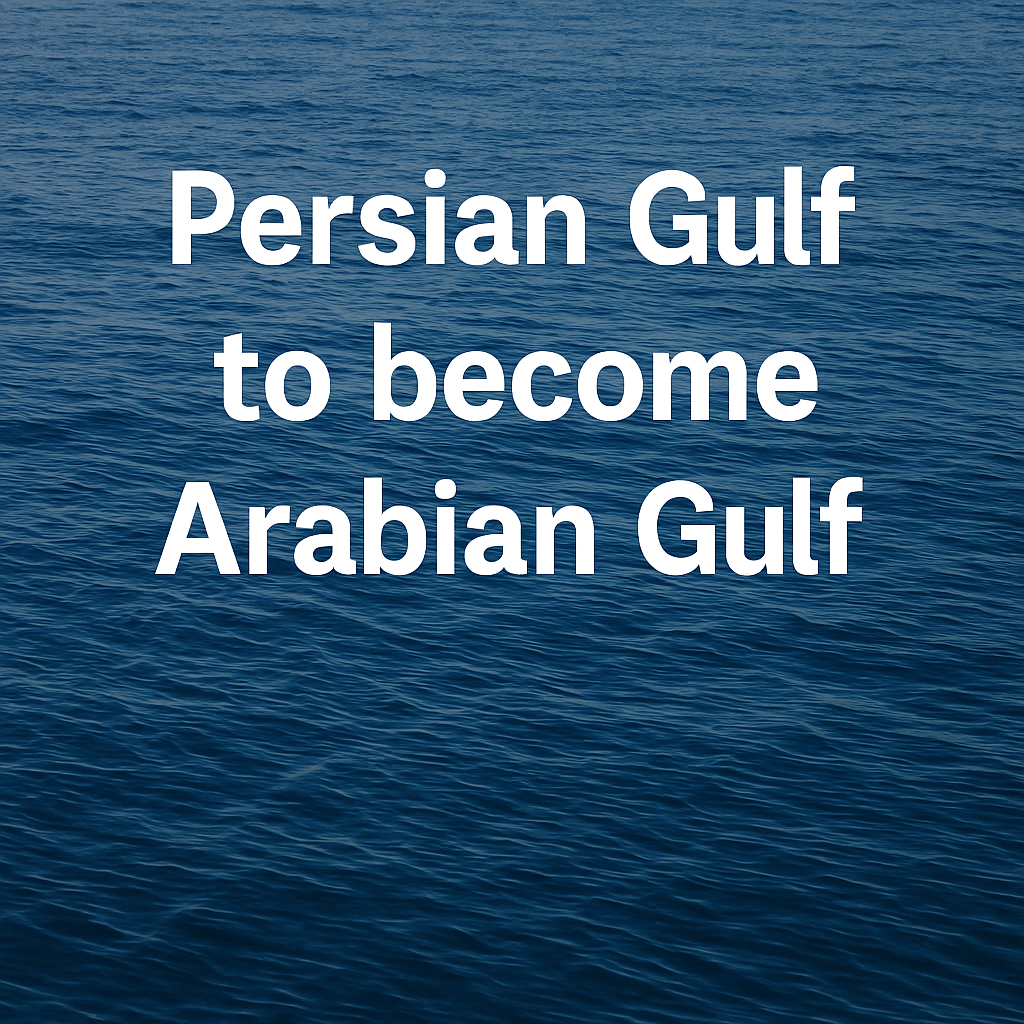
📅 May 9, 2025, Post 4: Persian Gulf to Become Arabian Gulf : Gulf of Names, Sea of Power: The Politics Behind Renaming the Persian Gulf | Mains Essay / Target IAS-26 MCQs Attached: A complete Package, Dear Aspirants!
Gulf of Names, Sea of Power: The Politics Behind Renaming the Persian Gulf

NEWS DROP — PETAL 004
🗓️ Date: May 9, 2025
🌍 Thematic Focus: GS2 – International Relations | Geopolitics | Mapping
🌿 Intro Whisper:
A sea may carry oil, history, or borders—but sometimes, it carries a name that nations are willing to fight for.
🔍 Key Highlights:
- What’s in News:
The United States government has decided to officially refer to the Persian Gulf as the Arabian Gulf (or Gulf of Arabia), a shift made to align with Arab allies such as Saudi Arabia, UAE, and Qatar.
🗺️ About the Persian Gulf
- A shallow marginal sea of the Indian Ocean.
- Bordered by:
- North & East: Iran
- South & Southeast: Oman, UAE
- Southwest & West: Saudi Arabia, Bahrain, Qatar
- Northwest: Kuwait, Iraq
- Connected to the Gulf of Oman and Arabian Sea via the Strait of Hormuz
- Freshwater inflows: Tigris, Euphrates, Karun rivers
- Approx. area: 93,000 sq miles
📜 Historical Context
- “Persian Gulf” – widely used since 1700s, symbolizing Iran’s ancient influence in the region
- Arab nations have long challenged this terminology, favoring “Arabian Gulf”
- The dispute reflects sectarian, national, and cultural divisions
🛢️ Economic and Strategic Importance
- Critical oil and gas reserves: major global energy supply hub
- Chokepoint for global shipping: ~1/5th of global oil flows through the Strait of Hormuz
- Regularly impacted by tensions between Iran and Gulf States
🌍 Geopolitical Implications of Renaming
- Seen as a diplomatic tilt toward Sunni Arab allies
- A symbolic challenge to Iran’s historical and cultural identity
- Could fuel regional hostility and harden rivalries in an already tense zone
- Reflects naming as soft power—where even terminology becomes geopolitical currency
🧭 International Naming Practices
- IHO (International Hydrographic Organization) typically recognizes “Persian Gulf”
- U.S. Military and some Arab states use “Arabian Gulf”
- Disparity reveals how cartography and politics intersect in world affairs
📘 GS Paper Mapping:
- GS Paper 2: International Relations | Bilateral & Regional Groupings | Foreign Policy Alignment
- GS Paper 1: Geography – Mapping & Physical Features
- Essay: “Naming the Sea: Identity, Sovereignty, and the Power of Words in International Politics”
🌠 Closing Thought:
When maps become battlegrounds, and names become weapons, diplomacy must rise—not to redraw lines, but to restore respect across them.
High Quality Mains Essay For Practice :
Word Limit 1000-1200
Naming the Sea: Identity, Sovereignty, and the Power of Words in International Politics
Introduction
In international politics, borders are not merely drawn on maps; they are etched into language, culture, and identity. The naming of geographical features such as seas, straits, and regions often reflects more than cartographic accuracy—it encapsulates historical claims, cultural memory, and assertions of power. A name becomes a symbol, a statement, and sometimes, a soft weapon in the grand theatre of diplomacy. The recent move by the United States to refer to the Persian Gulf as the “Arabian Gulf” underscores how naming is not a passive act of geography but an active expression of geopolitical intent.
This essay examines the implications of such decisions in global affairs, using the Persian Gulf dispute as a case study to explore how the politics of nomenclature influences sovereignty, identity, and international alignment.
Historical Significance of the Persian Gulf
The term “Persian Gulf” has been used since antiquity, recorded in maps, treaties, and historical texts for over 2,000 years. The name reflects the ancient Persian Empire’s maritime reach and the cultural influence of Iran (historically Persia) across the region. For Iranians, the term “Persian Gulf” is not merely geographical—it is symbolic of their civilizational legacy and regional stature.
The dispute arises from the 20th century onward, as emerging Arab nationalism, especially post-colonial, sought to redefine regional identity. The term “Arabian Gulf” began to gain currency, particularly in Arab nations that wanted to assert their own cultural space against Iran’s historical dominance.
Language as Power: Naming and Identity
A name is never neutral. When a state insists on a particular nomenclature, it is asserting its version of history, claim to territory, or place in global discourse. In the case of the Persian Gulf, Iran views any deviation from the traditional name as an erasure of its history. Arab states, on the other hand, argue that the term “Arabian Gulf” better reflects the current political realities, where most bordering states are Arab nations.
Thus, this naming conflict is about more than cartography—it is a contest between collective identities. For Iran, preserving the term “Persian Gulf” is a matter of national pride and heritage. For Arab states, using “Arabian Gulf” is an assertion of sovereign presence and regional leadership.
Geopolitical Implications of Renaming
The U.S. government’s decision to officially use the term “Arabian Gulf”—announced during a high-profile visit to the Middle East—is more than semantic. It is a diplomatic gesture toward Arab allies like Saudi Arabia, the UAE, and Bahrain. In a region fraught with sectarian and ideological divides, particularly between Shia-majority Iran and Sunni-majority Arab states, such symbolic moves carry significant weight.
By adopting Arab-preferred terminology, the United States signals alignment with Arab interests, particularly in its strategic balancing act against Iran. This can influence:
- Military cooperation in the Gulf region
- Oil diplomacy and energy corridor negotiations
- Regional alliances such as the Gulf Cooperation Council (GCC)
Simultaneously, it deepens mistrust with Iran, potentially escalating diplomatic friction and reinforcing a binary alignment in West Asia.
International Law and Cartographic Standards
The International Hydrographic Organization (IHO), the body responsible for naming water bodies globally, recognizes the name “Persian Gulf” in its official publications. Likewise, the United Nations has reaffirmed the use of the historical term.
Yet, global naming conventions are not universally binding. Different countries choose names based on diplomatic, cultural, or political preferences. For instance:
- The U.S. military and some NATO documents use “Arabian Gulf.”
- Most international atlases continue to use “Persian Gulf.”
- Media outlets and academia often use both terms, cautiously balanced.
This dissonance reflects a broader truth in international politics: language is contested terrain, and in naming lies both authority and allegiance.
Other Examples of Naming Disputes
The Persian Gulf controversy is not unique. Around the world, naming disputes mirror geopolitical tensions:
- Sea of Japan vs. East Sea – South Korea contests the Japan-centric naming.
- Macedonia – Greece’s opposition to North Macedonia’s original name stemmed from territorial and historical claims.
- Israel and Palestine – The use of Jerusalem or al-Quds reveals deep ideological lines.
- India’s insistence on “Azad Jammu and Kashmir” being called “Pakistan-occupied Kashmir (PoK)” underscores its territorial claim.
These instances show how geography becomes a medium for asserting narratives—whether colonial, nationalistic, or religious.
The Role of Soft Power and Media
In the age of digital maps and global media, naming disputes are amplified through platforms like Google Maps, Wikipedia, and international broadcasts. A term repeated enough gains legitimacy. This is why states lobby hard in international forums, cultural events, and even sports commentaries to popularize preferred terms.
The Gulf naming dispute is also a soft power battle. Arab nations have sought to institutionalize “Arabian Gulf” through organizations, sports leagues, and regional branding. Iran, in response, has launched campaigns to defend the “Persian Gulf” and considers alternative terms as acts of cultural aggression.
The Need for Diplomatic Balance
While symbolic, the naming of seas must be handled with diplomatic nuance. For third-party countries, adopting one name over another risks alienating allies. The best approach lies in respecting historical consensus, maintaining neutral cartographic standards, and avoiding provocation.
For international institutions and educators, the emphasis should remain on clarity, accuracy, and historical continuity. At the same time, sensitive dialogue should recognize the emotional and political stakes that naming holds for communities and nations.
Conclusion
What’s in a name? In international politics—everything. Names define history, narrate power, and shape perception. The Persian Gulf vs. Arabian Gulf dispute demonstrates how the battle for words can reflect larger struggles for influence, identity, and sovereignty.
As geopolitical narratives shift and new alliances form, the world must recognize that even the naming of a sea has the potential to stir a storm. Diplomacy, therefore, must extend not just to treaties and trade—but also to maps and meaning.
Quote to Conclude:
“Maps don’t just chart territory; they chart ambition.” — IAS Monk
Target IAS-26: Daily MCQs :
📌 Prelims Practice MCQs
Topic:
MCQ 1: Type-1 — “How many of the above statements are correct?”
Consider the following statements regarding the Persian Gulf and its geopolitical significance:
1. The Persian Gulf is connected to the Arabian Sea through the Gulf of Oman and the Strait of Hormuz.
2. The International Hydrographic Organization (IHO) officially recognizes the term “Arabian Gulf” in its publications.
3. Iran opposes the renaming of the Persian Gulf, citing historical and cultural identity.
4. The term “Arabian Gulf” has been historically used since the 1700s to describe the region.
How many of the above statements are correct?
A) Only two
B) Only three
C) All four
D) Only one
🌀 Didn’t get it? Click here (▸) for the Correct Answer & Explanation
✅ Correct Answer: A) Only two
🧠 Explanation:
1) Correct – The Persian Gulf flows into the Arabian Sea via the Gulf of Oman and Strait of Hormuz.
2) Incorrect – The IHO officially uses the term “Persian Gulf”, not Arabian Gulf.
3) Correct – Iran strongly opposes the change, viewing it as an attack on its heritage.
4) Incorrect – “Persian Gulf” has been used since the 1700s; “Arabian Gulf” is a modern political term.
MCQ 2: Type-2 — Two-Statement Assertion
Consider the following statements:
1. The naming of seas can influence diplomatic relationships and regional alliances.
2. The United States’ decision to use “Arabian Gulf” was intended to align with Arab nations and challenge Iranian influence.
A) Only 1 is correct
B) Only 2 is correct
C) Both are correct
D) Neither is correct
🌀 Didn’t get it? Click here (▸) for the Correct Answer & Explanation
✅ Correct Answer: C) Both are correct
🧠 Explanation:
1) Correct – Naming conventions can reflect foreign policy positions and affect alliances.
2) Correct – The renaming aligns with Arab preferences and signals strategic positioning against Iran.
MCQ 3: Type-3 — “Which of the above statements is/are correct?”
Consider the following statements about the Persian Gulf and its context:
1. The Persian Gulf is rich in oil and natural gas reserves.
2. Iran borders the southern coastline of the Persian Gulf.
3. The term “Arabian Gulf” is more widely accepted globally than “Persian Gulf.”
4. The Persian Gulf serves as a key international shipping route for crude oil exports.
A) 1, 2 and 4 only
B) 1 and 4 only
C) 1, 3 and 4 only
D) All four
🌀 Didn’t get it? Click here (▸) for the Correct Answer & Explanation
✅ Correct Answer: B) 1 and 4 only
🧠 Explanation:
1) Correct – It is a major hub for global energy supplies.
2) Incorrect – Iran borders the northern side of the Gulf.
3) Incorrect – “Persian Gulf” remains the internationally accepted term.
4) Correct – Nearly 20% of global oil exports pass through the Strait of Hormuz.
MCQ 4: Type-4 — Direct Factual Question
Which of the following countries does not border the Persian Gulf?
A) Bahrain
B) Kuwait
C) Jordan
D) Oman
🌀 Didn’t get it? Click here (▸) for the Correct Answer & Explanation.
✅ Correct Answer: C) Jordan
🧠 Explanation:
C) Jordan does not have a coastline on the Persian Gulf. It lies to the northwest of Saudi Arabia and has a small coastline on the Red Sea, not the Gulf.


















